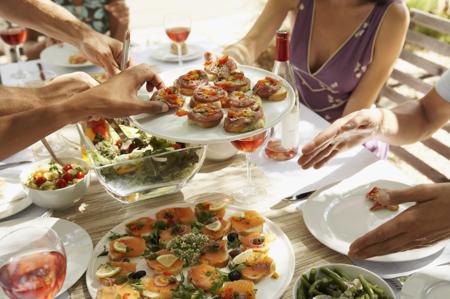Yikes!!! Did anyone see the new Newfoundland budget?! Probably a rhetorical question right? Here we are in Newfoundland trying to make the best of it. We’re already paying twice as much for food as most provinces and now we might have to pay more?! And people wonder why the rates in this province for Obesity, Diabetes, Heart disease among others are so high…well we just can’t afford to eat good can we? Well…hopefully I can make it a little easier on you by giving you a few tips! Here we go…
Getting Ready
- Before you even step foot in the grocery store you need to have a plan! Make a list of the foods you need and think ahead for the next week or 2. Based on the recipes you use most often I’m sure you’ll know what you need. Or you could be trying out a new recipe or 2 but keep it on the list. This will cut down on impulse buying and it will also help you remember everything so you’re not making another trip to the grocery store in 2 days because you forgot something and buying 5 other things you didn’t really need.
- NEVER and I mean absolutely never go to the grocery store hungry. I have done it, you have done it. I don’t know what happens but I black out and come to at some point in the line with my cart piled high with a million foods I know I will never eat but my stomach takes over and there I am with 8 bags of chips, 4 boxes of cookies, candy, ice cream, everything that is sweet or salty that I’m craving and usually buy in moderation but it ends up in my cart in triple the amount.
- Don’t put expensive ingredients you might never need again for recipes you haven’t tried on your list. A lot of spices and sauces are expensive. Borrow some from a friend until you find out if you like it or wait for it to go on sale, or simply google it! Sometimes you can find out different ways to make sauces with less exotic ingredients.
- Look for coupons. There are coupons that come in the mail and whenever you walk into a grocery store there is usually a flier or a wall of coupons that you can pick and choose from. For the more phone savvy, tech person, Sobeys and Dominion stores have apps to download that have coupons plus recipe ideas and more.
- Consider the No Name brand option. It can sometimes be the more delicious option. It might not always be cheaper but it most often is.
- Be aware of the stores in your area. Produce may be cheaper at No Frills, meat might be cheaper at Sobeys and Dairy might be cheaper at Dominion
Now I want to tackle the fresh versus frozen versus canned debate. Newfoundland is an island and let’s face it…the most exotic fruits and vegetables cannot be grown here, so, much of our produce is shipped. Now the nutrients in vegetables and fruits break down over time. Each day after they are harvested they degrade and add handling and transportation to that…by the time the food gets to our beautiful rock a lot of the nutrients have been lost. Enter frozen and canned foods. Prior to being frozen or canned, produce is blanched. This means it is dipped in boiling water for a timed interval and then removed quickly and flash frozen or dipped in ice water to stop the cooking process. This blanching process is required to stop the enzymes present in produce which cause the produce to rot over time. Side note: the browning that happens to an apple after it is cut is an enzyme process. The blanching and freezing keeps the produce at the peak of their nutrition. So…prepare yourselves for this…frozen fruits and vegetables can sometimes be a healthier option! If you don’t believe me I would encourage you to read some articles on the subject such as this one: here.
With all that being said:
Produce
- Buy fresh fruits and veggies that are in season. Grapes and Strawberries are NOT in season in the winter which is why you probably noticed in the grocery store this past winter that grapes were 14 dollars per bag and strawberries were 7.99 for a small tub. It is no problem to find strawberries for 2.99 in the summer (At one particular time I went into the grocery store while hungry and bought both strawberries AND grapes at these horrendous prices…but I was hungry and craving them. Another reason not to go to the grocery store hungry!!!).
- Buy frozen or canned produce when it’s on sale. Watch out for added salt and sugar in the juices in cans. Look for low sodium vegetables or fruit canned in their own juices and not syrup.
- Make a fun family outing in the summer and head to a you-pick or foresty/marshy area and pick blueberries, blackberries, raspberries or strawberries. It’s a family excursion, plus exercise and you can freeze extras for the long winter months.
- Do not wash fruit or vegetables until you’re about to eat it. Introducing water to them and then storing them wet can cause them to rot more quickly. Try storing berries, lettuce or other leafy delicate foods in a container with a paper towel to absorb extra moisture and keep them fresh longer.
Protein
- Look for deals. A lot of recipes are interchangeable. You can make tacos with chicken, beef, pork or beans. If pork is on your list but chicken is actually on sale then buy the chicken.
- Trade in 1-2 of your weekly meals for beans rather than meat. Beans are a much cheaper option and an excellent source of protein, they are also high in fibre and have zero fat. So, they are an excellent replacement for meat. Black beans and chick peas, for example, soak up the flavor of anything you cook them with. I have made burgers and tacos with black beans rather than beef and they were delicious!
- Buy canned tuna, salmon or chicken. These options can sometimes be cheaper and more convenient. Look for meat canned in water for a lower sodium option.
- Consider having a peanut butter sandwich rather than a meat sandwich. Peanut butter is a cheaper option and 2 tablespoons is considered a serving of protein.
Dairy
- Buy powdered milk to mix with water in recipes such as soups or puddings rather than regular cows milk.
At the end of the day, some of these tasks may seem tedious but it will become common nature eventually and save money in the long run. You might even find yourself preparing more at home and eating healthier (secretly that is always my hope! :)).
Signing off,
Adrianna Smallwood, RD
Registered Dietitian and Nutrition Expert




